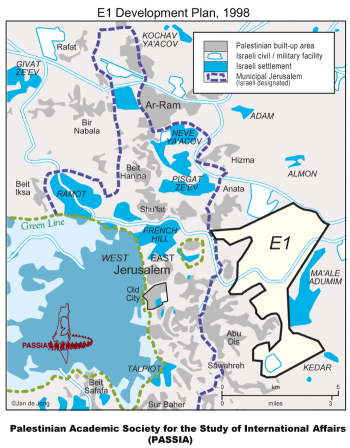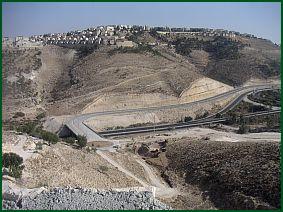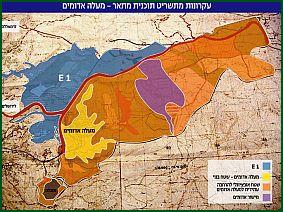Israel's E-1 Plan Report from Ir Amim
 Saturday, December 1, 2012 at 09:55PM
Saturday, December 1, 2012 at 09:55PM What is E-1?

http://eng.ir-amim.org.il/?CategoryID=180&ArticleID=153
E1 (derived from “East 1”) is a term applied by the Ministry of Housing to an area located just east of the Jerusalem municipal boundary, on the hills between Ma’aleh Adummim and Jerusalem. It lies north of the Jerusalem-Ma’aleh Adummim road and edges the Palestinian towns of Anata, Abu Dis, Azariya and A-Zayim. E1, which covers some 12,000 dunams (12 sq. kilometers), is part of the planning area of Ma'aleh Adummim. The main artery between the northern and southern West Bank runs through E1. Map

In recent years, Israel has begun building and settling the area. The development plan for E1 includes the transfer of the West Bank (Judea & Samaria) Police Headquarters from its present location, and the construction of at least 3,500 residential units, a large commercial center, and more. Plans for the E1 area make no reference whatsoever to the local Palestinian population. For more details
Construction in the E1 area commenced in 2004 under the direction of Housing Minister Efi Eitam. The work was illegal because no building permit had been issued. As a result of international pressure, construction was halted a short time after it began.

At the beginning of 2005, the Ma’aleh Adummim municipality approved two detailed urban plans for the development of the area, as mentioned above: one for approximately 3,500 housing units (apartment buildings and villas), and the second for the transfer of the police headquarters. The plan generated harsh criticism from the American government and the European Union. Both demanded that the plan be frozen, on the grounds that it violated Israel's commitments according to the 'Road Map.' Instead, they maintained that the future of this territory be decided upon by a final status agreement between Israel and the Palestinians. Following this pressure, the Israeli government froze the project in 2004. However, building of the police headquarters was continued on the grounds that, like army bases, the police station would not be seen as creating facts on the ground, but rather as a building that could be removed.
Nevertheless, the massive infrastructure built in the E-1 area in preparing for the police headquarters on the site, constitutes infrastructure appropriate for the establishment of a new neighbourhood.
The development plan for E1 includes:
The construction of at least 3,500 residential units (apartment buildings and villas) - for approximately 15,000 residents. The plan has been approved by the Ma’aleh Adummim Municipality in 2005, but at the moment it is still pending due to international pressure.
The transfer of the West Bank (Judea & Samaria) Police Headquarters from its present location in Ras El Amud to E1. In February 2006, after submitting the plans for public review and registering objections, the plan for the transfer of the police headquarters was approved.
An economic development zone - a joint venture of the Ma’aleh Adummim and Jerusalem municipalities. This part of the E1 plan has already received all final authorizations required for building to commence. The approved area for building encompasses approx. 1 million sq. meters (on an area sufficient for 10,000 housing units). It is situated in the north-east of E1, which borders on the village Anata and is adjacent to the new Border Police headquarters on the Ma'aleh Adummim-Jerusalem road.
Commercial Center
Hotels
Universities and "Special Projects"
Cemetery
Waste Disposal Site
A massive park - about 75% of the plan’s total area is earmarked for a park that will surround all the above components.
Plans for the E1 area make no reference whatsoever to the local Palestinian population as regards hospitals, schools, a cemetery, etc.

Ir Amim objects to the building of the Separation Barrier around E1, to the proposed construction in the area, and to the creation of a wedge between the West Bank and East Jerusalem. |
|
Allegedly, this controversy pertains to the city of Ma’aleh Adummim to the east of Jerusalem. But E1 is not a part of Ma’aleh Adummim. The proposed building in E1 differs in principle from building in the city of Ma’aleh Adummim -- both topographically and in terms of its political ramifications. E1’s inclusion within Ma'aleh Adummim's municipal boundaries was designed to give the impression that they are one and the same, but this is not the case. Often, the nature of the objections of the American government and other international players to Israel’s policies in the area is misrepresented. They are directed towards not at Ma’aleh Adummim proper, but against development in E1. This distinction is paramount, as the Americans, and even the Palestinians, are willing to accept an Israeli presence in Ma’aleh Adummim; but not in E1. The area of E1 should be seen for what it really is – a separate settlement – which, if built, will have long-term repercussions on the political process between Israel and the future Palestinian state. It seems that this insistence on building up E1 is intended to unilaterally pre-determine the future borders in the Jerusalem region, by creating "facts on the ground." Without prejudice to the status of Ma’aleh Adummim itself, Ir Amim maintains that it is necessary to preserve the territorial contiguity of the future Palestinian region with East Jerusalem, for the sake of the national interests of the State of Israel. The permanent borders of the area should be determined in negotiations between the two sides. Until then, no unilateral actions should be taken that might harm the feasibility of such negotiations. In fact, the development of E1 will split the West Bank in two and will cement Israeli control over East Jerusalem. This course of action may not only compromise the possibility of reaching an agreement, but may even prevent the opening of negotiations between the sides. |
Ir Amim's Role |
|
Halting Illegal Construction in E-1 Objection to Construction of the Judea and Samaria Police Headquarters To date, Ir Amim continues to monitor E-1 for new developments. -------------------------------------------------------------------------------- |
 APJP |
APJP |  Post a Comment |
Post a Comment |